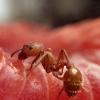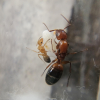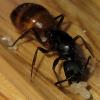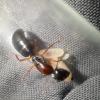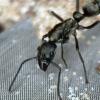On January 27th 2023 I took out my small Camponotus modoc colony from their dark case and notice the the queen and only worker were covered in little brown bump/warts. I tried to control my fear as I brought them under my desk light for closer inspection. That was when I realized just how many were there was about 50 on the queen and around 20 on the worker!🤯
Then I noticed the larger white mites crawling around in the test tube they were about 1.5 to twice the size of the brown bump mites on the ants. I brought out the queen and the worker and used a Q tip to clean them off, (much to their displeasure) and put them in a new test tube with a piece of lemon.
A Few Days Later:
The moving and cleaning of the ants had put a serious dent in the mite population. I then moved they into another new test tube.
I think that these are phoretic mites because I have yet to see and adult mite touching the ants and the young brown ones can’t move around on the ant at all because they don’t have legs. As of 1/31/23
Edited by FinWins, February 15 2023 - 11:41 AM.




